The role and influence of the
rulers of the Chauhan dynasty were confined to the regions of Bundi, Kota and
Jhalawar. Hence this area has been termed the Hadoti region. This area was a
treasury of art. The oldest specimens of prehistoric rock paintings in
Rajasthan are in the caves on the banks of the Chambal River near Kota. Its
temple architecture and iconography were famous from ancient times. Many
artistic temples located at Kansua, Badoli and Ramgarh testify to this fact.
Bundi
Style
The style of painting that
flourished wheh Bundi was ruled by Hada Rajputs is widely known as the Bundi
style. The natural beauty of this place comprising mountains covered with
luxuriant vegetation, lakes, streams and dense forests greatly influenced artists.
Historical
Background
Till the middle of the 14th
century A.D. (Sanvant 1398), Bundi, founded by Rao Deva, was a leading Rajput
state, but Bundi painting dated back to the time of Raja Surjan Singh
(1594-1598). Having severed his relations with Mewar, he surrendered the fort
of Ranthambor to Emperor Akbar and accepted the suzerainty of the Mughal
Empire.' His grandson Rao Ratan Singh (1607-1631) received the title Sar-Buland
Rai from Jehangir and established strong ties with the Mughals. Shatzusal, grandson
of Rao Ratan Singh (1631-1658), patronised many artists in his state. His son
Bhav Singh (1651-1681) was also a keen lover of art and encouraged his subjects
to take keen interest in poetry, music and painting.
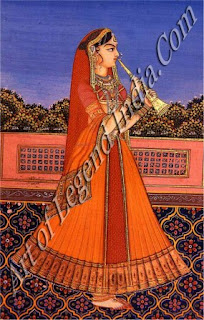 Poets like Mati Ram enjoyed the
patronage of Bhav Singh, whose Lalit-Lallam and Ras Raj greatly impressed
artists and lovers of art.' Bhav Singh and his son Anirudh Singh participated
in wars in the south under the direction of the Mughals.
Poets like Mati Ram enjoyed the
patronage of Bhav Singh, whose Lalit-Lallam and Ras Raj greatly impressed
artists and lovers of art.' Bhav Singh and his son Anirudh Singh participated
in wars in the south under the direction of the Mughals.
The southern style also
influenced the Bundi style in the reign of Rao Budha Singh (1695-1731). In 1710
Rao Bhim Singh of Kota annexed Bundi, but with the help of the Mahrattas Rao
Umaid Singh liberated it in 1748. As a result Bundi came under Mahratta
influence. In the 19th century Rajasthan came under British
influence, and Bundi shared this experience.
Development
No definite dates are available
regarding the origin of the Bundi style, but in the middle of the 18th
century facts about its historical background were known!' On the basis of
available material, two paintings concerning the Rag-Mala theme acquire
significant historical value. In the beginning of the 17th century
this style, a sub-branch of the Mewar school influenced by the Mughal style and
endowed with original qualities, flourished under the patronage of art-loving
kings.
Rao Chhattarsal constructed a
Rang Mahal which was decorated withfrescoes. From the text Lalit-Lallam could
be easily gathered facts about deeds of chivalry, art criticism and patronage
of art of Bhav Singh.
Many paintings of Rag-Ragini,
Nayika-Bhed, Krishna-Lila in his time now adorn private collections and
museums. Traditions of drawings on the basis of Ras Raj were initiated in this
period. Towards the end of this age, Lal Kavi compiled a decorative text for
Rao Budha Singh (1695-1731) which praised his sharp intellect and criticism of
art.
In the first part of the 18th
century the Bundi style flourished. This age, from the point of the abundance
of paintings and distinct characteristics, is a landmark in the development of
Rajput painting. The simplicity of early Bundi paintings and the impact of
Mewar started blooming into their true forms in this period. The Bundi style,
based upon traditional poetry and endowed with rich colours and attractive
forms, and physical structures reached its zenith.
In the middle of the 18th
century the style took a new turn in the period of Raja Umaid Singh
(1748-1771), in which the manifold diversities of nature and the physical
beauty of nayak-nayilca, the firmness of brush and charm of conception are
easily visible. Even though this style was greatly influenced by the Mughal
style, it had its own independent attraction. The collection in the Prince of
Wales Museum and the incomplete set of Rasikpriya in the National Museum belong
to this period.
Poetry and art made further
advance in the following years. Rao Raja Vishnu Singh (1773-1821) was, like his
father, a great connoisseur of art. Thousands of verses based upon shringar and
Bhakti he compiled himself are still available in manuscript. He painted many
texts on the basis of the traditional shringar style. At the beginning of the
19th century the whole country came under the influence of the Company style
the British introduced.
Bundi failed to counter this
new cultural force. Raja Ram Singh (1821-1889) of Bundi was a keen lover of
art. He commissioned many pictures and patronised artists on a large scale.
Paintings of this period however exhibit the impact of the West. Because of
this influence the Bundi style, like other styles of Rajasthani painting, began
to deteriorate. From the time of Raja Ram Singh light colours, a narrow range
of sentiment, lack of imagination and poor drawing began to appear. In the
second half of the 19th century the famous Bundi style of painting lapsed into
oblivion.
Salient
Features
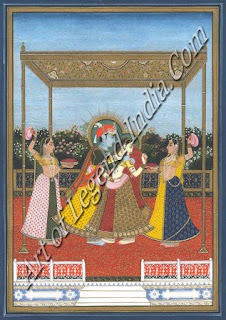 In the early Bundi style the
shape of the limbs of nayak-nayika and the arrangement of colours resemble
those of the Mewar school. Paintings of the 17th century were greatly
influenced by the southern style in representing female faces, foliage of
trees, starry skies.
In the early Bundi style the
shape of the limbs of nayak-nayika and the arrangement of colours resemble
those of the Mewar school. Paintings of the 17th century were greatly
influenced by the southern style in representing female faces, foliage of
trees, starry skies.
In the Bundi style tall human
figures with slim and graceful bodies are striking qualities. Women have deep
red lips, small noses, round faces and small chins. Their small necks decorated
with ornaments, embossed breasts tightly held up in brassieres, thin waists and
felicity of expression are special characteristics of this style. Male figures
wearing their turbans inclined downward, torsos covered with a long gown,
dupatta round the waist and tight pyjama falling to the feet characterize the
Bundi style. Men of fair complexion adorned with ornaments are easily
noticeable.
Another special feature of the
style is the application of seven colours in drawings of nature. These
paintings show blue skies partly covered with clouds, peacocks, squirrels,
parrots, heron, deer, monkeys, elephants, lions, bushy gardens and forests with
a variety of flowers and trees laden with fruits, ponds covered with creepers,
lotus blooms in which geese, vakul and fish are seen sporting. In short, the
beauty of nature in all its diversity, vastness and colour is present in the
Bundi style, and is not visible elsewhere except in the Kishangarh style.
The third highlight of the
Bundi style is its drawing of architecture. Dome-shaped Rajasthani cenotaphs
point skyward.
Subject
Ragragini, nayika-bhed,
ritu-varnan, Barah-masa, Krishna-Lila, royal court, festivals, wars are the
principal themes of the Bundi style. Because of the predominance of the
Vallabha sect pictures of Krishna-Lila were mainly painted. They included
Rasikpriya, Bihari Satsai, Ras Raj and other verses. Some of these texts had
flowed from the brushes of artists who had not chosen any poetic texts but were
based on their own poetry.
Kota
Style
The Kota style came into the
limelight in 1952 when Col. T.G. Gear Anderson presented his personal
collection to the Victoria and Albert Museum and some of the paintings were in
styles different from the Bundi style. For this reason the type of painting
which flourished in Kota is termed the Kota style, which may also be considered
a sub-branch of the Bundi style. But because of its originality and high
artistic quality its separate identity should be recognised.
Development
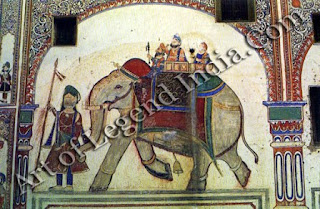 Favourably impressed by Mad ho
Singh Hada, son of Rao Ratan Singh of Bundi state, Emperor Shahjahan gifted him
a few territories as a token of esteem. As a result an independent state of
Kota came into being in 1631. But on the basis of available facts its
establishment is considered more likely by the end of the 17th century."
Favourably impressed by Mad ho
Singh Hada, son of Rao Ratan Singh of Bundi state, Emperor Shahjahan gifted him
a few territories as a token of esteem. As a result an independent state of
Kota came into being in 1631. But on the basis of available facts its
establishment is considered more likely by the end of the 17th century."
It is difficult to distinguish
between the earlier paintings and those in the Bundi style. Credit for creating
an independent Kota style goes to Raja Ram Singh (1696-1705). Many paintings of
his period are available even today." They reveal that the impact of the
Bundi style on the Kota style was considerable.
After Raja Ram Singh, Maharawal
Bhim Singh (1703-1720) paid special regard to the Krishna-Bhakti tradition. He
surrendered his palace and capital to Lord Krishna after having built a temple
and changed his name to Krishan Dass and Kota's name to Nand Gram and Barsana
of Shergarh.
Thus he made Kota Braj Bhoomi,
and this new move greatly influenced the artistic world of Rajasthan. Paintings
of his time depicting Krishna-Charitra are fairly easy to obtain. After
Maharawal Bhim Singh, Arjun Singh (1720-1764) also preserved the traditional
painting of Krishna-Charitra. Many paintings belonging to this time are
available in the State Museum, Kota. A pictorial Bhagwad text compiled in 1760
is presumed to be in the Mewar style, but many scholars believe it belongs to
the Kota-Bundi style pictorial texts. This text comprises 1190 pages and
hundreds of small and big paintings.
For a new landmark in the Kota
style of painting credit goes to art-loving Raja Umaid Singh (1771-1820). He
also had a strong inclination for hunting. The dense forests of Kota abounded
with many wild animals like lion, tiger, cheetah, pig, and deer. In the reign
of Umaid Singh artists took a keen interest in depicting hunting themes, and
the Kota style acquired a great reputation for painting such scenes.
In the darbar hall of the
palace many frescoes are based on the Krishna-Lila epic,
Hadot-i-School and among
hundreds of miniatures in the Great Palace many relate to Krishna-Charitra. Two
pictorial texts belonging to the beginning of the 19th century depict the
significance of the Pushti sect. One of them a text of entitled
Valla-bhotsava-Chandrika decorated with beautiful pictures relating to Vallabhacharya
and his seven sons, seven attributes, and various festivals in 12 months had
been created." The other, Gita Panchmel, is a similar artistic text of six
paintings concerning Radha-Krishna and their attributes. This tradition of the
Kota style continued to be popular in the reign of Raja Ram Singh II
(1822-1866), but the British influence heralded its downfall like that of
others.
Salient
Features
The Kota style has some
characteristics-of-the Bundi style, but its own distinct features. Because of
the influence of the Vallabha sect, male and female links are like those of go swamis
and priests Stout bodies, shining faces, bulging eyes are special features of
the Kota style. Application of green, red and golden colours in Kota style
painting is very pleasing to see. Animals painted in this style include deer,
tiger, lion and pig.
The style of painting relating
to the Hadoti School belonged to Jhalawar and other important feudal states
besides the Kota and Bundi styles. Ancient cave paintings have also been found
in this region, and paintings in the Bundi style are found in art museums all
over the world. Probably Bundi has earned the distinction of having produced
the largest number of paintings in Rajasthan.
Writer - Jay Singh Neeraj
 Poets like Mati Ram enjoyed the
patronage of Bhav Singh, whose Lalit-Lallam and Ras Raj greatly impressed
artists and lovers of art.' Bhav Singh and his son Anirudh Singh participated
in wars in the south under the direction of the Mughals.
Poets like Mati Ram enjoyed the
patronage of Bhav Singh, whose Lalit-Lallam and Ras Raj greatly impressed
artists and lovers of art.' Bhav Singh and his son Anirudh Singh participated
in wars in the south under the direction of the Mughals.  In the early Bundi style the
shape of the limbs of nayak-nayika and the arrangement of colours resemble
those of the Mewar school. Paintings of the 17th century were greatly
influenced by the southern style in representing female faces, foliage of
trees, starry skies.
In the early Bundi style the
shape of the limbs of nayak-nayika and the arrangement of colours resemble
those of the Mewar school. Paintings of the 17th century were greatly
influenced by the southern style in representing female faces, foliage of
trees, starry skies.  Favourably impressed by Mad ho
Singh Hada, son of Rao Ratan Singh of Bundi state, Emperor Shahjahan gifted him
a few territories as a token of esteem. As a result an independent state of
Kota came into being in 1631. But on the basis of available facts its
establishment is considered more likely by the end of the 17th century."
Favourably impressed by Mad ho
Singh Hada, son of Rao Ratan Singh of Bundi state, Emperor Shahjahan gifted him
a few territories as a token of esteem. As a result an independent state of
Kota came into being in 1631. But on the basis of available facts its
establishment is considered more likely by the end of the 17th century."
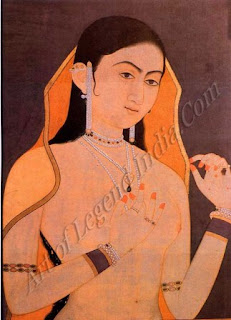
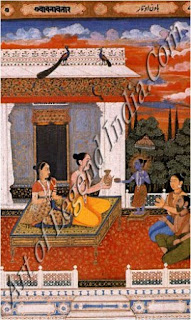
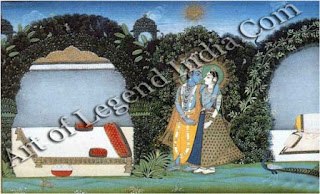
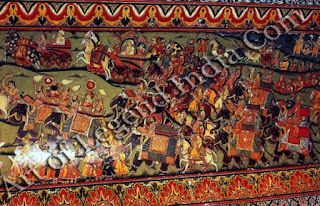










0 Response to "Hadoti School Painting"
Post a Comment